Combat aircraft. Dolittle's rabid middling
The plane entered history already on April 18, 1942, when 16 B-25 Mitchell medium bombers under the command of Lieutenant Colonel James Doolittle, taking off from the American aircraft carrier Hornet, attacked Japanese territory for the first time in this war.
It was indeed a very daring operation that had more political significance. Like the Soviet bombing of Berlin in 1941.
Then there was the routine work on all the battlefields of the war where the Americans appeared. From the Pacific Ocean to Europe.
It all started as usual: a competition to create a medium twin-engined bomber for the US Army. The aircraft was supposed to fly at a speed of 480 km / h for a range of up to 3 km with a bomb load of 220 kg.
Four firms came together in the competition. Martin introduced the Model 179, North American the NA-62, the Douglas the B-23, and the Steerman the P-23.
He won the project "Martin", which became the B-26 "Marauder". But the military also liked the North American project, and the company got a chance to bring the plane to its logical conclusion. The B-26 went into production, and the B-25 was refined.
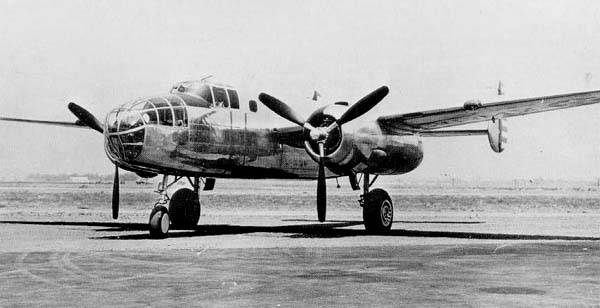
As a result, the North American engineers did a tremendous job. The main task was to simplify the design in order to simplify as much as possible the maintenance and repair of the aircraft in the field. In addition, the aircraft turned out to be very simple to operate, which facilitated the task of mass training of personnel and flight crews.
The B-25 went into production a little later than the B-26 and a little less, but went on.
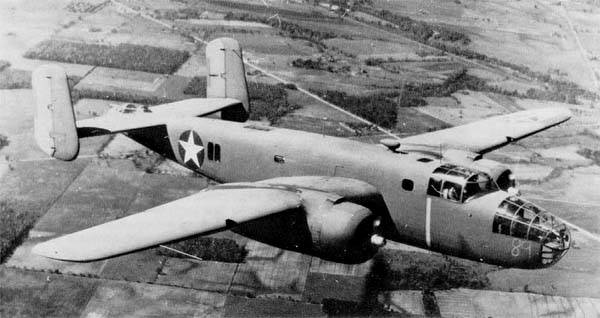
In the process of fine-tuning, the designers did their best to improve the aircraft. Initially, the B-25 was supposed to be powered by Wright "Cyclone" R-2600 engines with a capacity of 1700 hp. In the course of work, the idea of installing more powerful Pratt & Whitney R-2800 with a capacity of 2000 hp came up. The idea was good, but the manufacturers of fighters, on which these engines were primarily used, were outraged.
The plane turned out to be peculiar. The pilots were seated nearby, which was not very convenient with the fuselage width of 144 cm.
The navigator was placed under the pilots. The view from the cockpits was excellent, it was a pleasure to steer, take off and land.
It took a long time to decide how to make the tail unit, with a classic keel or two end washers. The puck side won, because they gave a better view and did not interfere with the machine guns of the rear defense sector.
The defensive armament was downright weak. One 7,62-mm machine gun in the bow course mount.
The second is the same at the rear of the fuselage. The third machine gun, 12-7 mm, was placed in the tail section in the fairing.
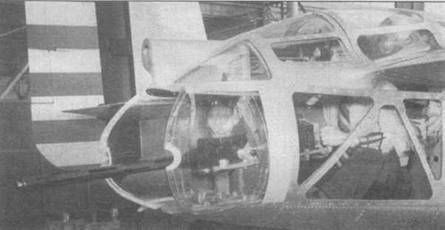
The bomb armament was very diverse. The aircraft could take one 908 kg bomb or torpedo, a cluster with 12 bombs 45,4 kg, or various combinations of bombs weighing 113,5 kg, 136,2 kg, 227 kg, 272,4 kg and 499,4 kg.
The crew consisted of five people. The pilots sat in the cockpit, the navigator was located under them, plus he was also burdened with a course machine gun. One gunner lay in the tail near a 12,7 mm machine gun, the second gunner was controlled with a 7,62 mm machine gun firing backward and upward and a machine gun firing through the side windows.
The fuel tanks were located in the wings, four with a volume of 3 467 liters and one discharged fuselage for 1 liters. The engines provided a flight speed of 590 km / h at an altitude of 534 m. The propellers were equipped with an anti-icing system. There was no reservation on the plane.
The first flight took place on August 19, 1940. The aircraft obeyed the rudders well, but during flights it turned out that there was exchange rate instability. Any gust of wind knocked the car off course. USAAC flight test inspectors gave the aircraft a negative assessment, but engineers managed to eliminate the problem by simply redesigning the wing consoles.
However, these modifications took a long time and the plane flew again only in February 1941. The flights were successful and the aircraft was put into mass production.
The new aircraft received the official designation B-25 "Mitchell" in honor of Brigadier General William Mitchell, who is considered the father of the American aviation... The name was suggested by North American Vice President John Lee Atwood, and the military liked the idea.
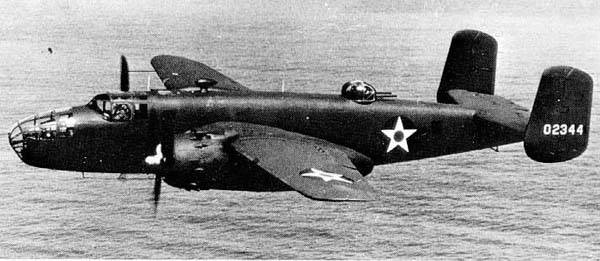
By that time, the war was in full swing in Europe and the American military was very closely following the tactics of using bomber aircraft. The successes of Germany, using precisely medium bombers, could not fail to attract attention.
Several points immediately became clear: if the bombers flew without fighter cover, then they were easily shot down by enemy fighters. The classic defensive weapons of the time were rapidly becoming weak. Plus, anti-aircraft artillery developed more and more, which made it difficult for the bombers to operate.
American designers quickly realized that there was no perfect defense, but nevertheless took steps to protect aircraft. Self-sealing fuel tanks and armor that protected the crew's seats began to be installed on the aircraft. The armor was only 1 mm thick, that is, it protected only from fragments. But - it's better than nothing.
It is clear that in connection with these modifications, the weight of the aircraft has increased, and the flight characteristics have deteriorated somewhat. Vehicle weight increased from 7835 kg to 8112 kg. To reduce the weight of the aircraft, the volume of the fuel tanks in the wings had to be reduced to 2 liters. Naturally, the flight range was reduced, from 619 km to 3 km. The ceiling also dropped, from 218 m to 2 m.
But this did not stop the American designers, on the contrary, they took the path of strengthening weapons. The engineers from the famous Bendix company helped, who developed an electric turret for two 12,7 mm machine guns from the Colt Browning.
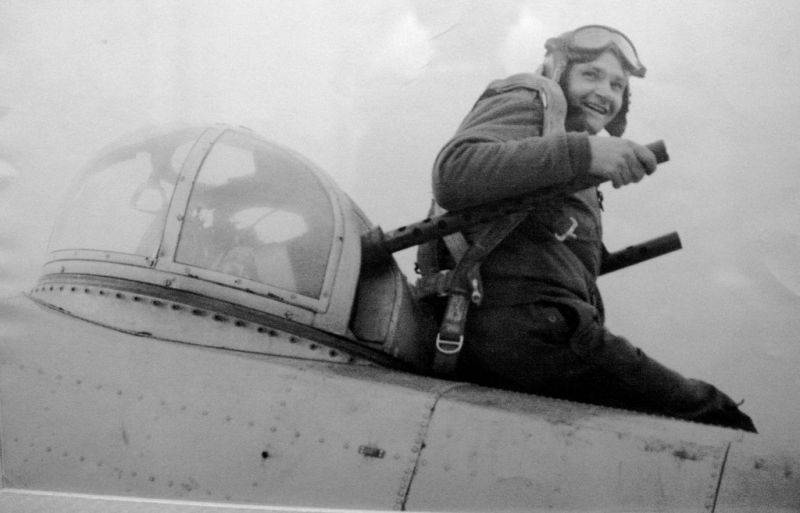
An experiment was carried out with the installation of turrets above and below the navigator's seat. The lower turret could be extended if necessary, the shooter aimed the machine guns with a periscope sight, which was not very convenient. But the turrets had a circular firing sector without "dead" zones. This made it possible to remove the tail firing point. As a result, only the course machine gun remained from the original set of weapons. This version was named B-25B.
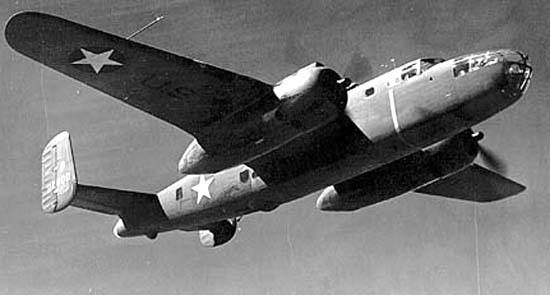
The rejection of the tail turret had its consequences. It turned out to be possible to remove the excess armor in the tail, remove the side windows in the fuselage. However, the turrets made the plane heavier. Accordingly, the speed dropped to 482 km / h, and the ceiling to 7 m.
In September 1941, the first B-25 vehicles began to enter combat units. The first combat use took place after the Japanese attack on Pearl Harbor. B-25s patrolled the US West Coast in search of submarines. In 1942, B-25s began similar patrol flights over the East Coast, but in search of German submarines.
The improvement of the B-25, taking into account the use of bombers in theaters of operations, continued.
By that time, Wright had prepared a new 2600 hp Cyclone R-13-1700 engine. The aircraft received an anti-icing system, the autopilot, the tail crutch produced was replaced with a fixed crutch in the fairing. They installed a cabin heating system, a new bomber sight. Instead of a course 7,62-mm machine gun, two 12,7-mm machine guns were installed, one of which was fixed motionless, and the second could be guided within a small sector.
Bomb racks were installed under the wings, and torpedo mounts under the fuselage. An emergency landing gear system was introduced.
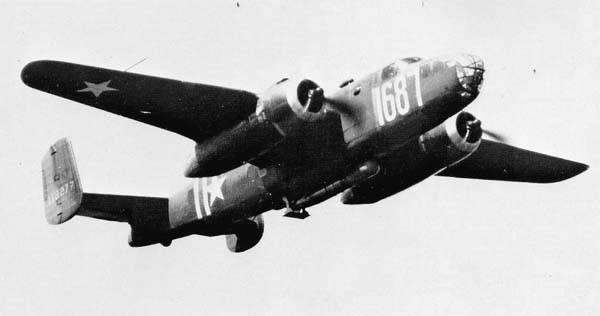
These aircraft began to be referred to the B-25D series.
In general, it turned out to be a very, very good car. Strong and unpretentious. On the battlefields, the B-25 was used "to the fullest," but, as it turned out, the aircraft could easily be modified with a "hammer and file" in the field for any task.
For example, the use of the B-25 in the Pacific Ocean gave rise to the field modification of the B-25 "Strafer". The fact is that bombing from a conventional flight was not always effective. The ships managed to evade bombs, and it was also very difficult to take into account the ocean gusts of wind. Plus, the Japanese snapped back fire from their 25-mm anti-aircraft automatic cannons.
The use of the topmast method of striking was not as effective as we would like. The aircraft were forced to descend and came under fire from enemy anti-aircraft installations.
Therefore, an attack aircraft appeared, whose task was to suppress the enemy's anti-aircraft points. The pilot could carry out the attack without the help of the navigator, so 4 12,7 mm machine guns were placed in the navigator's cabin. Another 2-4 of the same machine guns were placed on the sides of the cockpit. The cockpit glass was replaced with an armor plate.
Conversion of aircraft was carried out in Australia, which was closer to the hypothetical "front line". So several dozen aircraft were converted, which took the most direct part in the battle in the Bismarck Sea. Attacks by aircraft, in the nose of which were batteries of large-caliber machine guns, literally swept air defense crews from the decks, significantly weakening anti-aircraft fire. This made it possible for torpedo bombers and bombers to work more calmly.
Working on ground objects such as airfields on the islands, the Americans began to equip aircraft with clusters of 100 bombs, 10 kg each. These small bombs literally plowed airfields, making them unusable.
Such bombs were no less effective against the Japanese air defense batteries.
The idea with "Strafer" turned out to be very successful. In total, 175 aircraft were refitted by the Australians. The attack aircraft "entered" because it could simultaneously suppress the air defense crews and deliver a bomb strike.
And in Europe, the assault modification did not come to the court. Moreover, "North American" approved the idea and began to install in the nose two 12,7-mm machine guns with 250 rounds of ammunition each at the factories. A number of aircraft were converted at bases in the Mediterranean. They installed 6 machine guns in the nose, but the idea did not take root.
On the contrary, I had to think about how to strengthen the defensive armament, since the Luftwaffe fighters inflicted very significant losses on American bombers. Another field modification appeared, which began to be produced at a plant in Georgia.
The lower turret was removed from the vehicles, the hole in the bottom of the fuselage was welded tightly. Two windows were made in the sides, in which they put on a 12,7-mm machine gun. In addition, two 12,7 mm machine guns were again installed in the tail cockpit, which served the shooters again planted in the tail section.
At the Sidi-Ahmed base in Tunisia, the planes were re-equipped, installing armor: armored seats, instrument panel, bomb bay, floor and sides of the tail firing point were additionally armored.
So almost 300 cars were converted almost handicraftly, and many of the improvements appeared on serial cars of subsequent versions.
At one time, in 1942, work was underway to clarify the possibility of installing 25-mm guns on the B-37 under the wings in containers, and even installing a 75-mm gun in the bow. But the project was not approved and the work was stopped.
The B-25 was also reworked in the interests of the US Navy. These aircraft were designated PBJ-1C and PBJ-1D. The aircraft were equipped with AN / APS-2 radars and the LORAN navigation system. In the bow, 3 12,7 mm machine guns were installed and two machine guns along the sides of the fuselage. In the modified bomb bay, it was possible to transport sea barrage mines, and instead of them, the aircraft could take a torpedo or 10 unguided 127-mm HVAR missiles on the external suspension. Under the wings, the plane could carry another 454 kg of bombs.
Naturally, he served as a B-25 in the Royal Air Force of Great Britain. At the very beginning of the war, they were sent a batch of B-25Bs, which the British called "Mitchell" I and which were used as training aircraft.
And in September 1942, the first B-25Cs arrived in Britain, they are also "Mitchell" II. On January 27, 1943, the first use of the B-25 by the British took place: six bombers took part in a raid on an oil storage facility in Ghent. The fuel tanks were set on fire, but two planes were shot down by German fighters and one by anti-aircraft gunners.
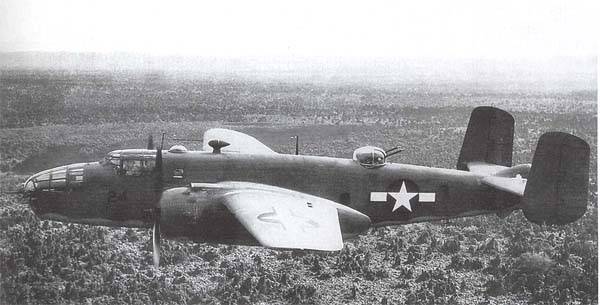
Great Britain received 167 B-25Cs and 371 B-25Ds. These aircraft served in the Royal Air Force until 1946, after which they were withdrawn to the reserve and decommissioned.
The Mitchells were not only used by the British. The combined forces of the allies included Polish, Dutch and French squadrons. This once again testifies to how simple the plane was to control and master.
B-25s were also in service with Canada. 173 aircraft were in service with the Canadian Air Force, were used mainly for patrolling and anti-submarine warfare. After the war, the B-25 was transferred to training and in this role they flew until 1958.
But the main role "Mitchell" played in the Pacific Ocean. Having proved to be undemanding, maintainable, easy to operate and, most importantly, capable of long-distance flights, the B-25 firmly established itself in the flight units of the Pacific theater of operations. The Mitchells, taking off from makeshift airfields on the islands, hunted for ships, bombed airfields and supply routes.
B-25s worked throughout the entire Pacific theater of operations, from Burma to New Guinea. The fighting on the islands in the Pacific was significantly different from the fighting on the continent: the lack of good concrete runways, the absence of a solid front line and well-organized air defense, as well as many small scattered targets.
And in this regard, the B-25 turned out to be simply a masterpiece: the B-17 was too heavy for improvised airfields, the B-26 was too delicate for such operating conditions.
Therefore, at -25, entire regiments were rearmed, which terrorized the Japanese positions and the coastal zone of the islands, firing and dropping bombs on any target, from supply ships to firing points.
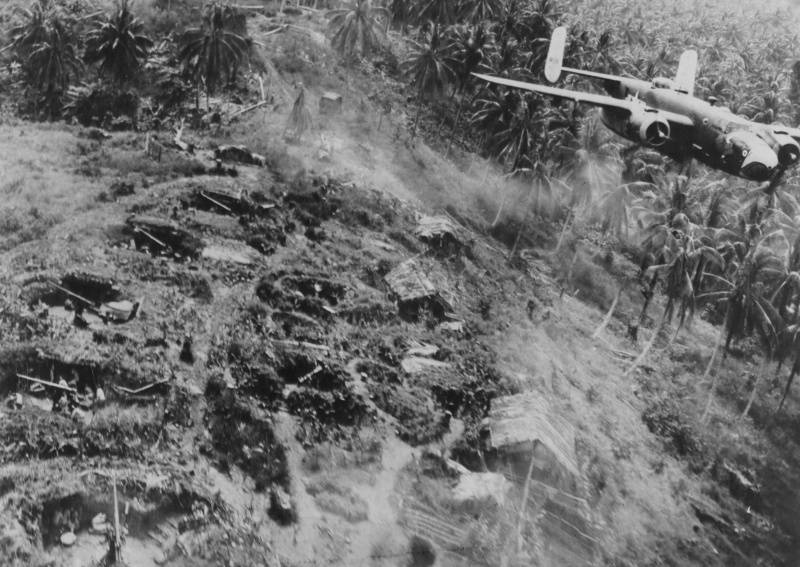
On the continent, in Burma and China, B-25s acted in the same way: they disrupted the supply routes of the Japanese army wherever possible.
When the Allies launched an offensive in Burma in 1944, the air force supported the advance of the ground forces not only with bombs, but also with bales. The B-25s became a reliable source of supplies for soldiers who marched through the jungle. The soldiers walked through the jungle light, and everything they needed was thrown from the sky. Aircraft also replaced artillery: from January 1944, assault modifications of the B-25, versions H and G were actively used.
The northernmost point of application was the Aleutian Islands. B-25 flew there, striking at the landing Japanese troops.
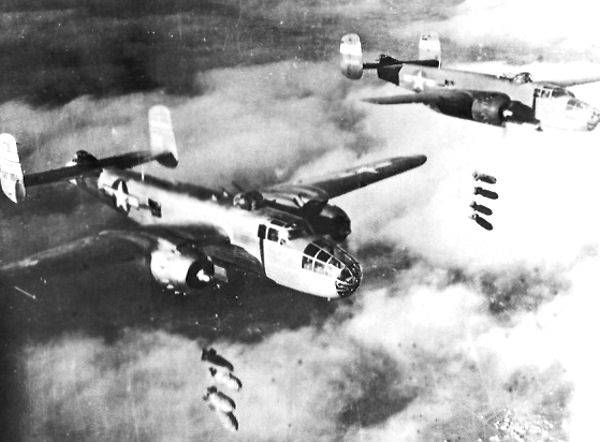
Since 1942, the Mitchells have supported British troops in North Africa, and have raided Sicily and Italy.
Naturally, the B-25 ended up in the Red Army Air Force. Moreover, unexpectedly for himself in the role of a long-range bomber.
And at first the plane did not appear to be our representative “the same”. But when the plane flew around Mikhail Gromov, the opinion changed dramatically and the B-25V began to enter the USSR under Lend-Lease, and from 1942 - the B-25C.
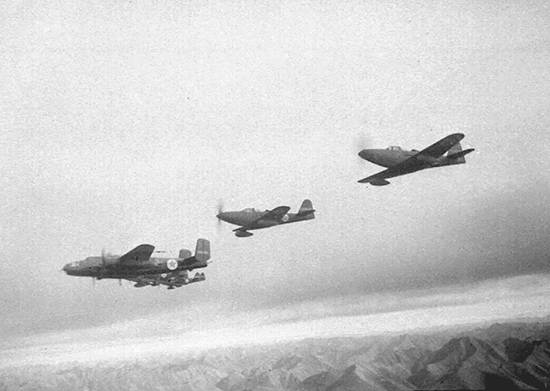
In the Red Army Air Force, "Mitchell" was in the role of a long-range night bomber, striking targets behind the front line. And in the role of a long-range aviation aircraft, the B-25 stayed very well: before the appearance of the Tu-4 / B-29.
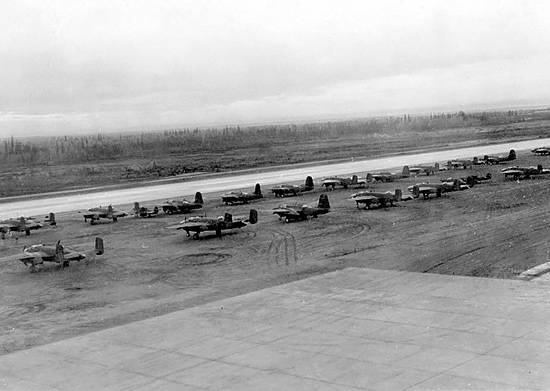
The tactics of using bombers in the Red Army Air Force differed somewhat from the American one: in the United States, several dozen aircraft bombed at medium altitudes, and in the USSR, several machines attacked targets close to the ground. As a result, large and not very agile, the Mitchells suffered losses from anti-aircraft fire.
But for raids on rear objects of the Germans, the B-25 was just perfect. Excellent radio navigation equipment, a decent combat radius, bomb load almost twice that of the IL-4 - all this made the Mitchell an ideal vehicle for such tasks.
If we remember that the basis of long-range aviation was completely outdated IL-4, which did not differ in "minced meat", then the B-25 was able to strengthen our ADD.
It’s a paradox, but the Mitchell did not possess outstanding characteristics, and in terms of flight qualities it was inferior even to the “internal competitor” - the B-26 Marauder bomber of a similar purpose. But "Mitchell" had its own "trick": its main trump card was performance. They were especially pronounced in the Soviet Union.
The Il-4 was operated by one pilot, while it was difficult to control and the pilot could only dream of a decent autopilot. In addition, our bomber did not have anti-icing devices, which were more than useful when flying at high altitude.
The advantage of "Mitchell" was the possibility of free movement of the crew inside. For example, a pilot could help a wounded gunner. And of course, in comparison with the IL-4, the Mitchell possessed simply luxurious defensive weapons. Yes, there were claims to the lower turret, but 6 large-caliber machine guns from Mitchell against one 12,7-mm drill collar and two 7,62-mm ShKAS looked just gorgeous. As a result, despite the fact that by the end of the war the B-25 was used more intensively than the Il-4, the relative losses of American aircraft were half that.
In general, as a bomber, the B-25 was perfect for the conditions in which he had to work. What's on the Eastern Front, what's on the Pacific Ocean.
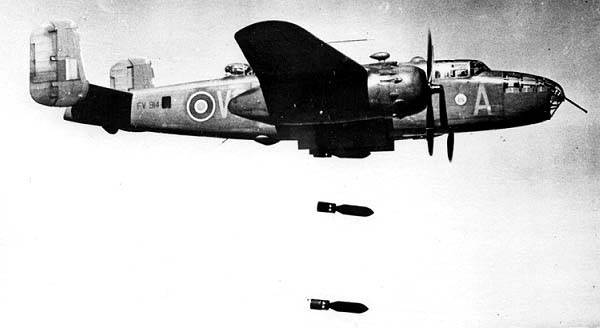
This allowed a seemingly quite average aircraft not only to hold out in the series until the end of the war, but to maintain full combat effectiveness.
More than a hundred B-25s have survived to this day, about four dozen Mitchells are flightable.
But if we talk about our realities, the B-25 played another very significant role. When, after the war, the question arose about the production of a copied B-29 under the Tu-4 brand, the engineers and pilots who dealt with the B-25 became very useful consultants for the Tupolev Design Bureau engineers who copied the plane. Thanks to their joint work, a very decent autopilot AP-5, an improved copy of the Si-1, turned out.
The middle one. As it is - average. He did not fly as far as the IL-4. Not as high as the Ju-88A-4. Not as good in terms of flight characteristics as the B-26. Carrying fewer bombs than He-111. But in the end he fought the entire war and went down in history, becoming the same symbol of the American Air Force as the P-47 Thunderbolt or the B-17 Flying Fortress. Not outstanding characteristics, but outstanding merits, since all fronts of the Second World War, without exception, became the front for the use of the B-25.
And it costs a lot, you must agree.
LTH B-25C
Wingspan, m: 20,60
Length, m: 16,13
Height, m: 4,83
Wing area, м2: 56,67
Weight, kg
- empty aircraft: 9 206
- normal takeoff: 15 420
Engine: 2 x Wright R-2600-13 "Cyclone" x 1700 hp
Maximum speed km / h: 459
Cruising speed, km / h: 375
Practical range, km: 2 420
Practical ceiling, m: 6 460
Crew, prs: 5
Armament:
- six 12,7 mm machine guns;
- 1 360 kg bombs or 1 torpedo 907 kg.
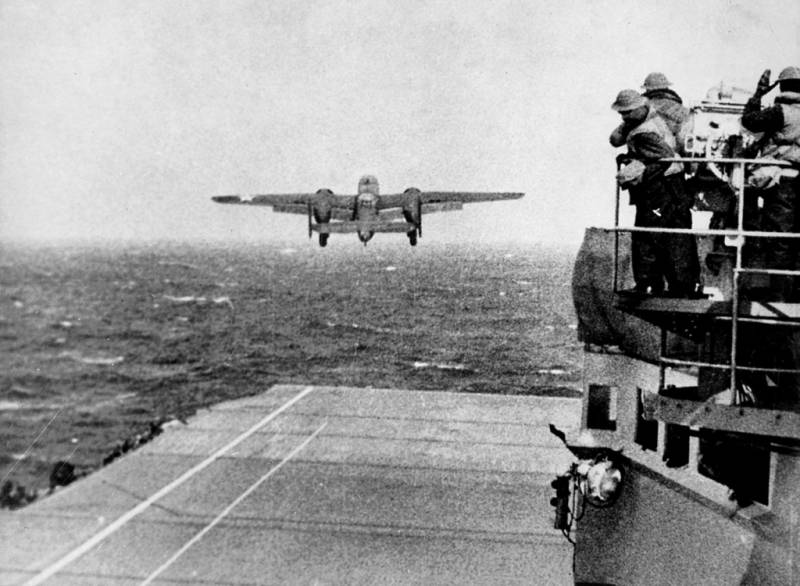
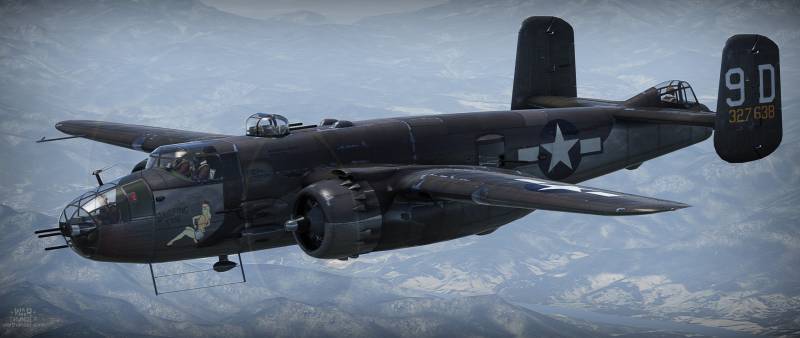
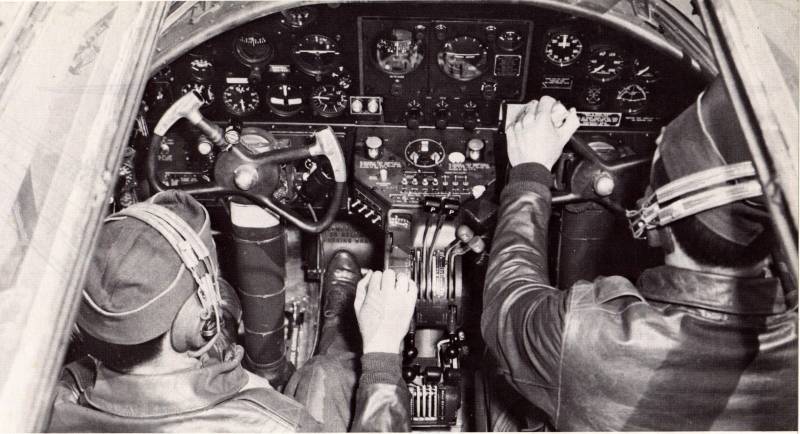
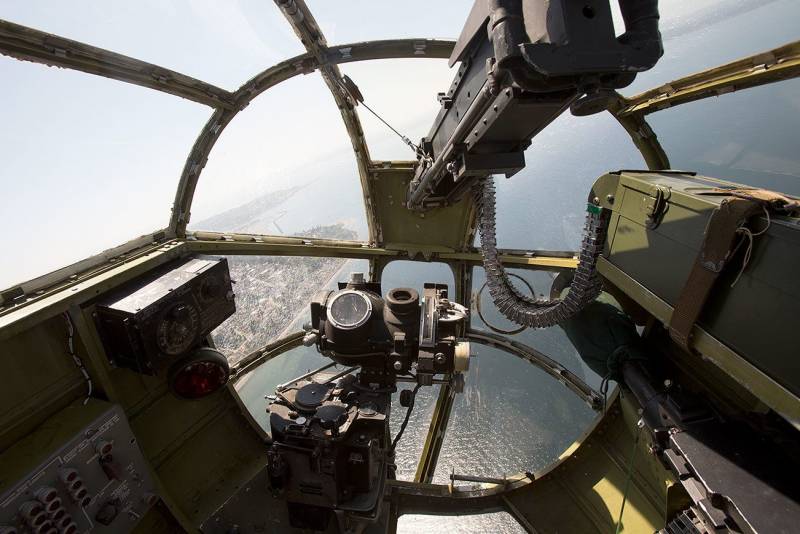
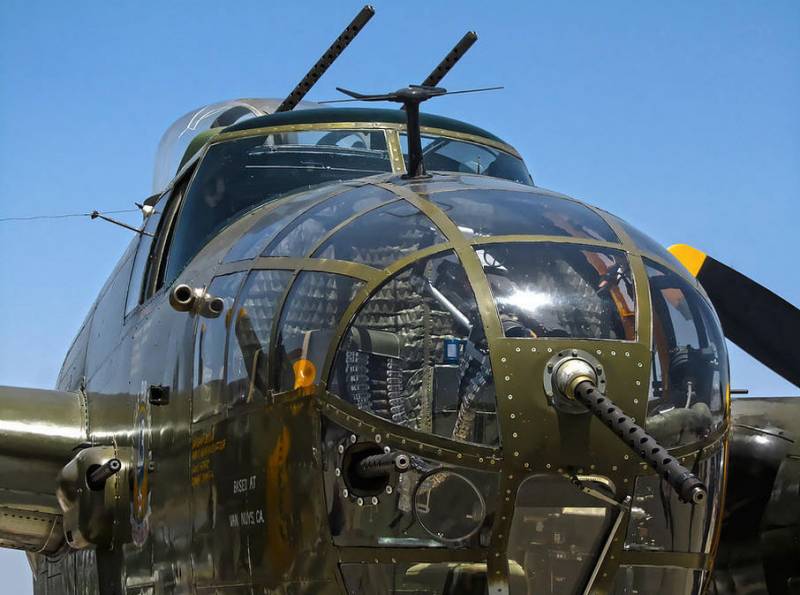
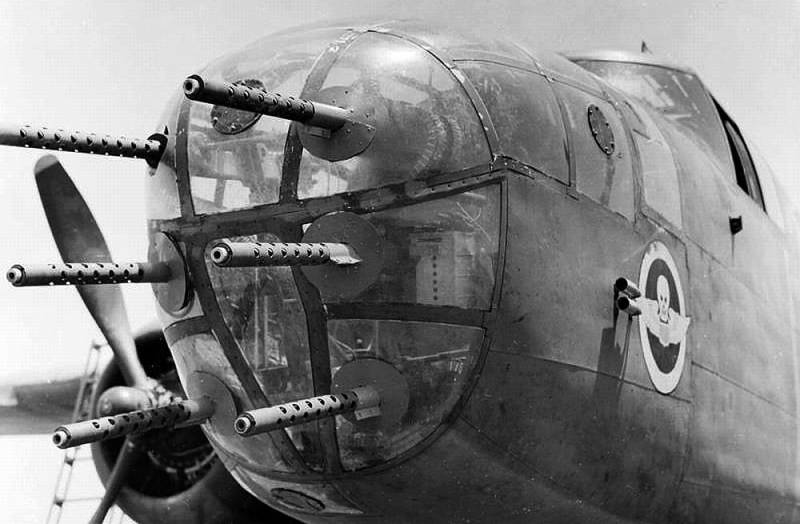
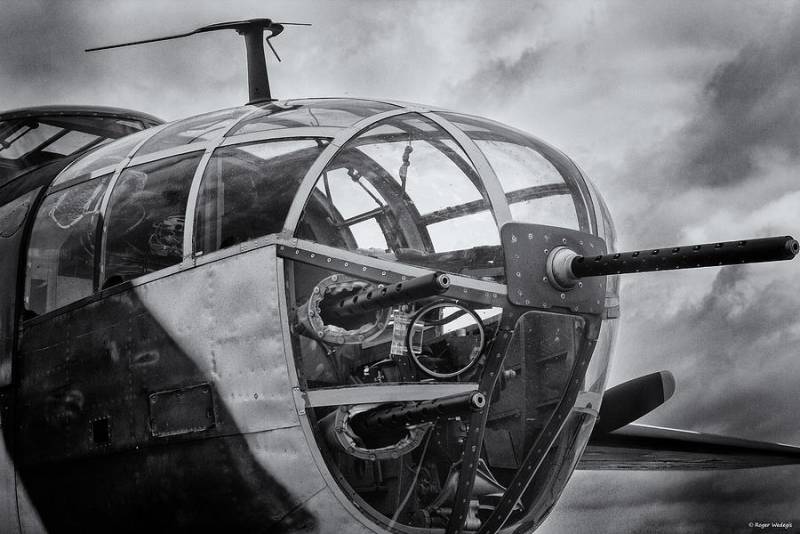
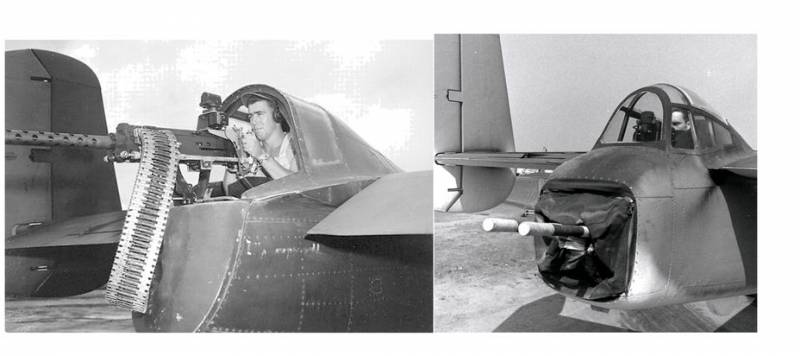
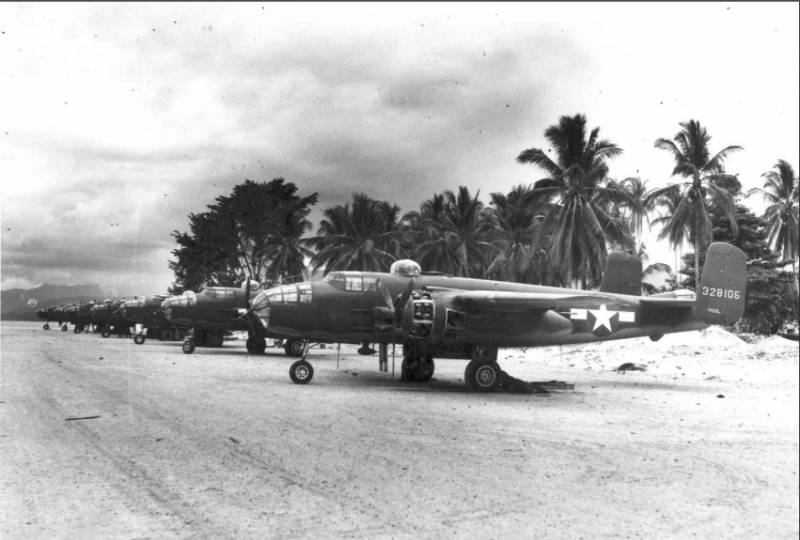
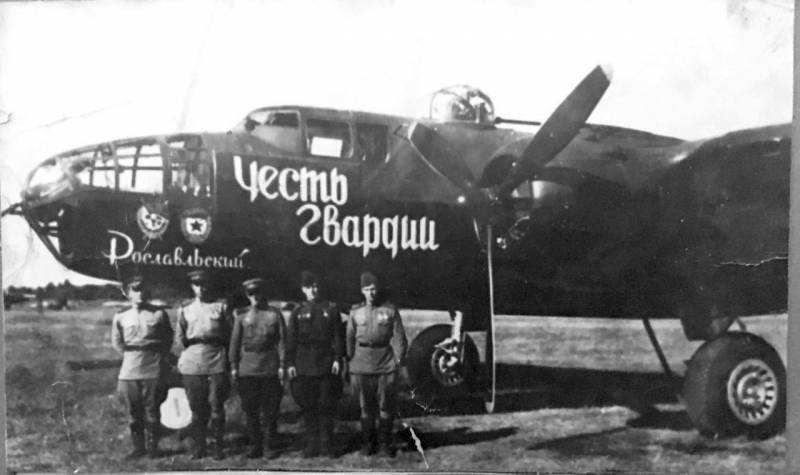
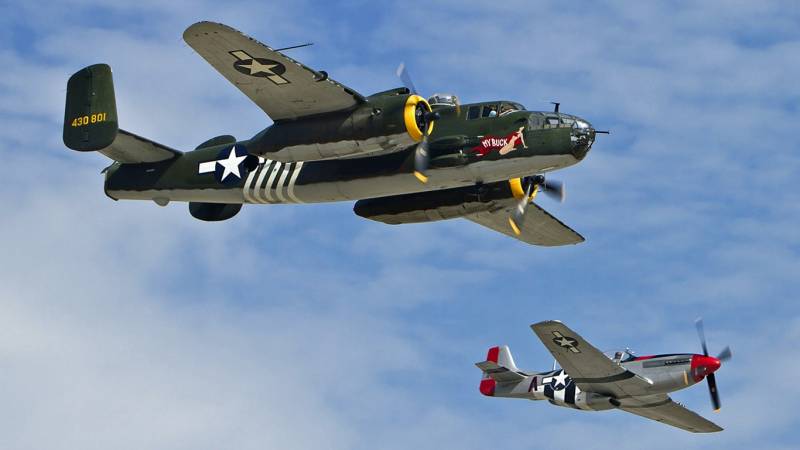
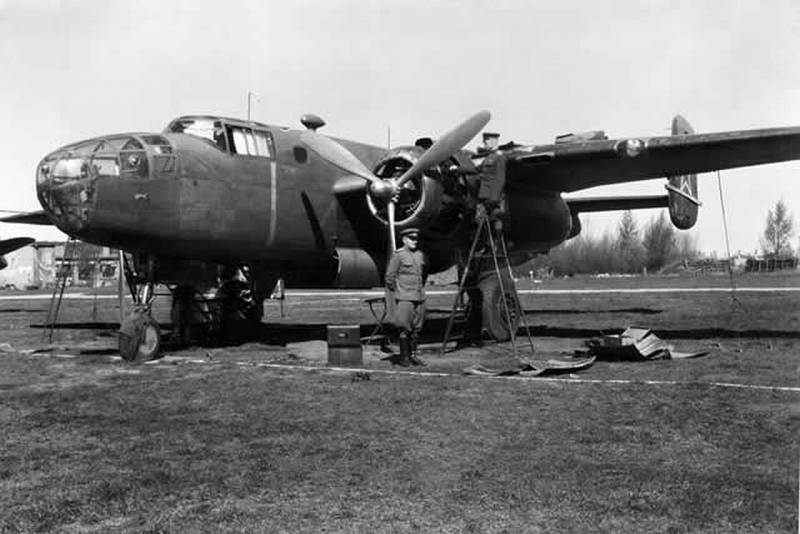
Information